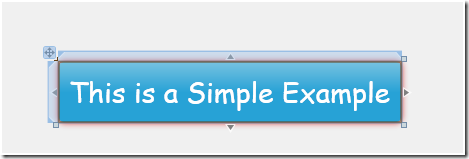1:新建自定义控件PopupBorder,作为Popup的child。代码如下:
<UserControl x:Class="SLStudy.PopupBorder" xmlns="http://schemas.microsoft.com/winfx/2006/xaml/presentation" xmlns:x="http://schemas.microsoft.com/winfx/2006/xaml" xmlns:d="http://schemas.microsoft.com/expression/blend/2008" xmlns:mc="http://schemas.openxmlformats.org/markup-compatibility/2006" mc:Ignorable="d"> <UserControl.Resources> <Storyboard x:Name="myStoryboard"> <DoubleAnimation Storyboard.TargetName="LayoutRoot" Storyboard.TargetProperty="Opacity" From="1.0" To="0" Duration="0:0:1" AutoReverse="True" /> </Storyboard> </UserControl.Resources> <Grid x:Name="LayoutRoot" > <!--<Border Background="#FFCC0D0D" BorderThickness="0" CornerRadius="5">--> <Border BorderThickness="0" CornerRadius="5"> <Border.Background> <LinearGradientBrush EndPoint="0.5,1" StartPoint="0.5,0"> <GradientStop Color="#FF27A3D7" Offset="0.51"/> <GradientStop Color="#FF76C2E1" Offset="0.004"/> <GradientStop Color="#FF27A3D7" Offset="1"/> </LinearGradientBrush> </Border.Background> <Border.Effect> <DropShadowEffect BlurRadius="10" Color="#FFCC0D0D" ShadowDepth="0"/> </Border.Effect> <TextBlock x:Name="txtMessage" HorizontalAlignment="Center" Margin="10" VerticalAlignment="Center" FontSize="28" Foreground="White" FontFamily="Comic Sans MS" >This is a Simple Example</TextBlock> </Border> </Grid> </UserControl>
新建PopupDemo页面,代码如下:
<Grid x:Name="LayoutRoot"> <StackPanel> <Button Content="Show" Click="ShowPopup_Clicked"></Button> </StackPanel> </Grid>
后台cs代码为:
private void ShowPopup_Clicked(object sender, RoutedEventArgs e) { Popup popup = new Popup(); //设置popup的Child属性为自定义的用户控件。 popup.Child = new PopupBorder(); popup.IsOpen = true; }
运行,效果如下:
注册popUp的LayoutUpdated事件,在触发LayoutUpdated事件时,设置popUp的Margin属性:
popUp.LayoutUpdated += delegate { popUp.Margin = new Thickness( (App.Current.Host.Content.ActualWidth - pborder.ActualWidth) / 2, (App.Current.Host.Content.ActualHeight - pborder.ActualHeight) / 2, 0, 0); };
完整的代码如下:
PopupBorder pborder = new PopupBorder(); Popup popUp = new Popup(); //设置popup的Child属性为自定义的用户控件。 popUp.Child = pborder; popUp.LayoutUpdated += delegate { popUp.Margin = new Thickness( (App.Current.Host.Content.ActualWidth - pborder.ActualWidth) / 2, (App.Current.Host.Content.ActualHeight - pborder.ActualHeight) / 2, 0, 0); }; popUp.IsOpen = true;
运行可以发现弹出的消息已经居中了,那么如何让它自动消失呢??,
要想自动消失还得使用定时器,过了一段时间后定时器将popUp控件的 IsOpen属性设置为false,这样窗口就关闭了。
于是在LayoutUpdated中增加定时器代码:
popUp.LayoutUpdated += delegate { popUp.Margin = new Thickness( (App.Current.Host.Content.ActualWidth - pborder.ActualWidth) / 2, (App.Current.Host.Content.ActualHeight - pborder.ActualHeight) / 2, 0, 0); System.Threading.Timer timer = new System.Threading.Timer( (state) => { popUp.Dispatcher.BeginInvoke(() => { popUp.IsOpen = false; }); }, null, 500, 500); };
在过了500秒后,将popUp. IsOpen设置为false。
运行可以发现窗口可以自动消失了。
可以看到弹出窗口一下就关闭了,那么能不能慢慢的渐变的消失呢??
为了实现渐变的消失,那么就应该使用动画了。
首先在PopupBorder中增加
<UserControl.Resources> <Storyboard x:Name="myStoryboard"> <DoubleAnimation Storyboard.TargetName="LayoutRoot" Storyboard.TargetProperty="Opacity" From="1.0" To="0" Duration="0:0:1" AutoReverse="True" /> </Storyboard> </UserControl.Resources>
当然上面的PopupBorder代码中已经有了这段代码了,动画使用了DoubleAnimation,设置LayoutRoot 对象的Opacity属性在1秒的时间内从1,变到0。
接着在PopupDemo页面的按钮事件里面在popUp.Child = pborder;后面增加如下代码来执行动画:
//设置popup的Child属性为自定义的用户控件。 popUp.Child = pborder; pborder.myStoryboard.Completed += delegate { popUp.IsOpen = false; }; pborder.myStoryboard.Begin();
然后将Clicked中的代码进行重构。
新建MessageBoxHelper类:
代码如下:
public class MessageBoxHelper { #region 提示消?息¡é /// <summary> /// 弹出提示消息标题为提示,按钮为确定 /// </summary> /// <param name="msg"></param> public static void ShowMessage(string msg) { //ShowFriendMessage(msg, "提示", MessageBoxButton.OK); PopupBorder pborder = new PopupBorder(); pborder.txtMessage.Text = " " + msg + " "; pborder.UpdateLayout(); Popup popUp = new Popup(); popUp.Child = pborder; pborder.myStoryboard.Completed += delegate { popUp.IsOpen = false; }; pborder.myStoryboard.Begin(); popUp.InvokeOnLayoutUpdated(() => { popUp.Margin = new Thickness( (App.Current.Host.Content.ActualWidth - pborder.ActualWidth) / 2, (App.Current.Host.Content.ActualHeight - pborder.ActualHeight) / 2, 0, 0); System.Threading.Timer timer = new System.Threading.Timer( (state) => { popUp.Dispatcher.BeginInvoke(() => { popUp.IsOpen = false; }); }, null, 500, 500); }); popUp.IsOpen = true; } /// <summary> /// 弹出提示消息按钮为确定 /// </summary> /// <param name="msg"></param> public static void ShowMessage(string msg, string title) { ShowMessage(msg, title, MessageBoxButton.OK); } /// <summary> /// 弹出提示消息 /// </summary> /// <param name="msg"></param> public static void ShowMessage(string msg, string title, MessageBoxButton buttons) { MessageBox.Show(msg, title, buttons); } #endregion }
使用的时候只需要MessageBoxHelper.ShowMessage(“Hello World”);就可以了。注意别忘记了PopupBorder控件。
本文转自LoveJenny博客园博客,原文链接:http://www.cnblogs.com/LoveJenny/archive/2011/07/14/2105869.html,如需转载请自行联系原作者
